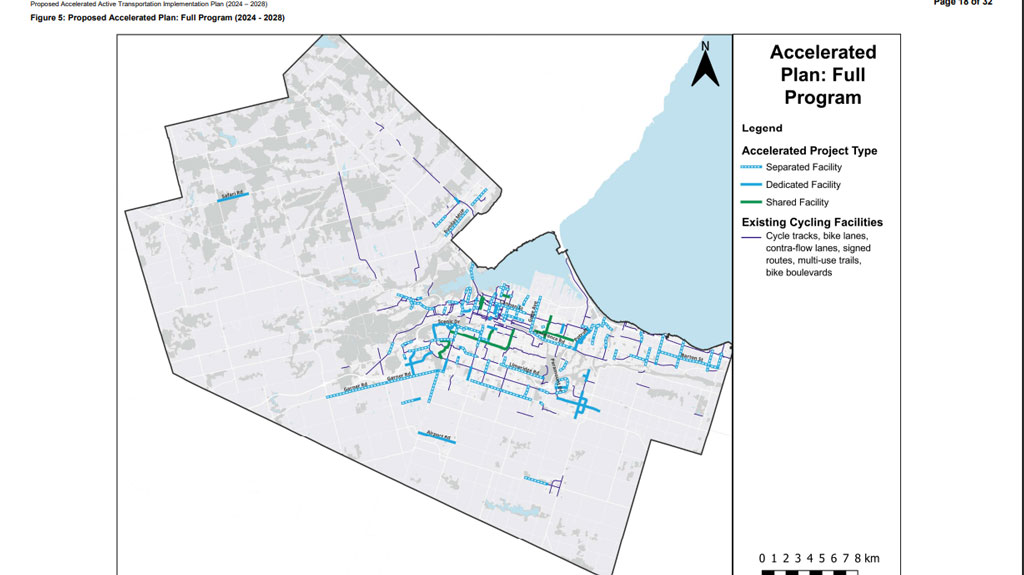In an accelerated development of the city’s cycling network, the addition of more than 140 kilometres of new or improved bike lanes and multi-use pathways was recently introduced to Hamilton City Council.
This will double the amount of Hamilton bike lanes added or improved each year, in what has been named the “Accelerated Active Transportation Implementation Plan.”
The proposal includes upgrading existing bicycle lanes to AAA status — a design standard set by the National Association of City Transportation Officials.
This new standard would see the bike lanes separated by low rise concrete curbing as opposed to the painted line and plastic bollards that were crushed due to contact with vehicles on the original cycling lanes on Cannon Street in the city’s east end.
“The accelerated plan is intended to guide and focus efforts and investments over the next five years. The plan identifies some $60 million in investments, which collectively would result in an additional 119 kilometres of new cycling facilities bringing the city to about 75 per cent completion for the Cycling Master Plan,” said Brian Hollingworth, director of transportation, planning and parking, City of Hamilton.
In a chapter in the plan titled, It’s a Floor; not a ceiling, it states, “The adoption of the Accelerated Plan should be viewed as a foundational step rather than an ultimate destination. Viewing this plan as the floor acknowledges the dynamic nature of urban development and transportation needs.
“Our city is evolving, and as population growth, environmental concerns and social needs continue to shape the urban landscape, flexibility in planning becomes paramount. By considering the current plan as a baseline, the city remains open to adjusting and expanding cycling facilities to meet future demands and seize unforeseen opportunities.”
The report deems the cycling network a “game changer” as the plan will see 81 kilometres of new separated facilities (separated bike lanes, raised cycle tracks, multi-use paths), 17 kilometres of new dedicated facilities (buffered and painted lanes) and 21 kilometres of new shared facilities (bike boulevards) implemented over four years.
“The city’s current Cycling Master Plan (CMP) was completed in 2018 as part of the city-wide Transportation Master Plan and identifies approximately 970 kilometres of bike lanes, cycle tracks, multi-use paths and other facilities (e.g. paved shoulders and bike boulevards). Approximately 60 per cent of the planned cycling network has been implemented with 40 per cent remaining,” said Hollingworth.
Next steps to achieve the goals of the accelerated plan for 2024 to 2028 are to present the strategy to council and complete projects through existing or new capital works, co-ordinated through the capital budget submission process.
To date, approved funding will come from the Investing in Canada Infrastructure Program, which will provide approximately $500,000 per year over the next 10 years. Federal and provincial funding is expected to cover some of the projects as well.
Completion of a study is also on the agenda as well as working through the operating budget to identify additional funding and/or resources that are required to ensure both existing and future infrastructure is adequately maintained.
The city will also continue to hire previously approved positions to finalize the Integrated Active Transportation Delivery Team and begin reporting on the team’s activities.
Hamilton is not the only Canadian municipality making greater efforts to enhance their active transportation networks through master plans, increased funding, and more ambitious and protective infrastructure design.
Along with Hamilton’s 151 kilometres, at 30 kilometres per year of new and enhanced facilities, are Montreal’s 200 kilometres at 40 kilometres per year of added express cycling facilities and Waterloo Region’s 200 kilometres over 10 years at 20 kilometres per year, which aims to create a comprehensive cycling grid across the Kitchener-Waterloo region.




Recent Comments
comments for this post are closed